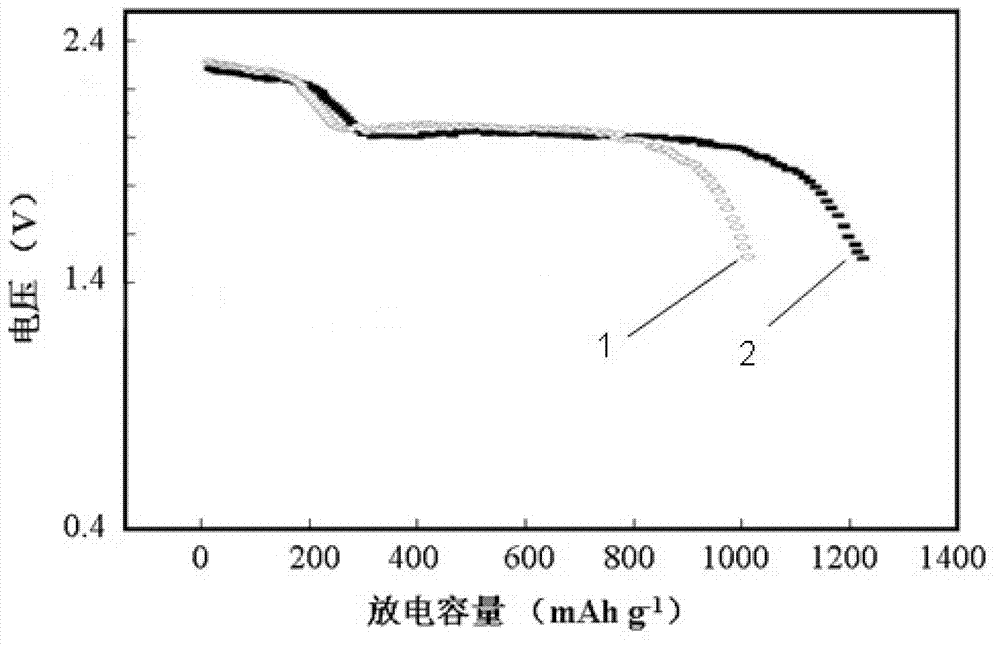Preparation method of indole-modified carbon sulfur-coated and compound lithium sulfur battery anode material
A lithium-sulfur battery and cathode material technology, applied in battery electrodes, secondary batteries, circuits, etc., can solve the problems of unfavorable high-rate performance of batteries, poor mechanical stability of electrodes, and large volume changes, so as to improve electrochemical power Chemical properties, reduced electrode polarization, uniform particle size
- Summary
- Abstract
- Description
- Claims
- Application Information
AI Technical Summary
Problems solved by technology
Method used
Image
Examples
Embodiment 1
[0026] Example 1: Preparation of hollow carbon ball precursor
[0027] Dissolve 2 g of glucose in 100 mL of deionized water, stir to dissolve and introduce it into a reactor with a total capacity of 150 mL. Then add 10 g of spherical aluminum powder with a purity of 99.99% and a particle size of 1 to 5 microns, add magnets, and seal the reactor. The reaction kettle was placed in an oil bath at 250°C, and the reaction kettle was taken out after 2 hours of magnetic stirring and reaction. After the reactor is cooled to room temperature, open the reactor and centrifuge to obtain a brown or black solid powder sample (hollow carbon ball precursor).
Embodiment 2
[0028] Example 2: Carbonization of precursors
[0029] Dissolve 5 g of sucrose in 100 mL of deionized water, stir to dissolve, and introduce it into a reactor with a total capacity of 150 mL. Then add 10 g of spherical aluminum powder with a purity of 99.99% and a particle size of 5-10 microns, add magnets and seal the reactor. The reaction kettle was placed in an oil bath at 250°C, and the reaction kettle was taken out after 4 hours of magnetic stirring. After the reactor is cooled to room temperature, open the reactor and take out the filtered product. The product is in the form of brown or black solid powder, washed with water and ethanol, centrifuged, dried under vacuum at 40℃, and heated to 500℃ under nitrogen atmosphere, constant temperature Carbonize for 5 hours.
Embodiment 3
[0030] Example 3: Preparation of hollow carbon balls
[0031] Dissolve 10 g of starch in 100 mL of deionized water, stir to dissolve, and introduce it into a reactor with a total capacity of 150 mL. Then add 10 g of spherical aluminum powder with a purity of 99.99% and a particle size of 5-10 microns, add magnets and seal the reactor. The reaction kettle was placed in an oil bath at 250°C, and the reaction kettle was taken out after 8 hours of magnetic stirring and reaction. After the reaction kettle is cooled to room temperature, the reaction kettle is opened, and the filtered product is taken out. The product state is brown or black solid powder, washed with water and ethanol, and centrifuged. After vacuum drying at 40°C in a tube furnace, the temperature was raised to 600°C under the protection of a nitrogen atmosphere, and the temperature was carbonized for 3 hours. After cooling to room temperature, take out the sample and treat it with 1 wt% dilute hydrochloric acid at ro...
PUM
| Property | Measurement | Unit |
|---|---|---|
| particle diameter | aaaaa | aaaaa |
| pore size | aaaaa | aaaaa |
| particle diameter | aaaaa | aaaaa |
Abstract
Description
Claims
Application Information
 Login to View More
Login to View More - R&D
- Intellectual Property
- Life Sciences
- Materials
- Tech Scout
- Unparalleled Data Quality
- Higher Quality Content
- 60% Fewer Hallucinations
Browse by: Latest US Patents, China's latest patents, Technical Efficacy Thesaurus, Application Domain, Technology Topic, Popular Technical Reports.
© 2025 PatSnap. All rights reserved.Legal|Privacy policy|Modern Slavery Act Transparency Statement|Sitemap|About US| Contact US: help@patsnap.com


